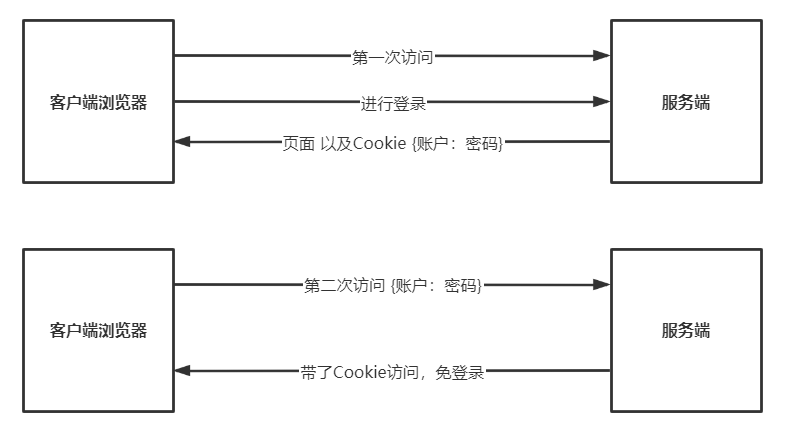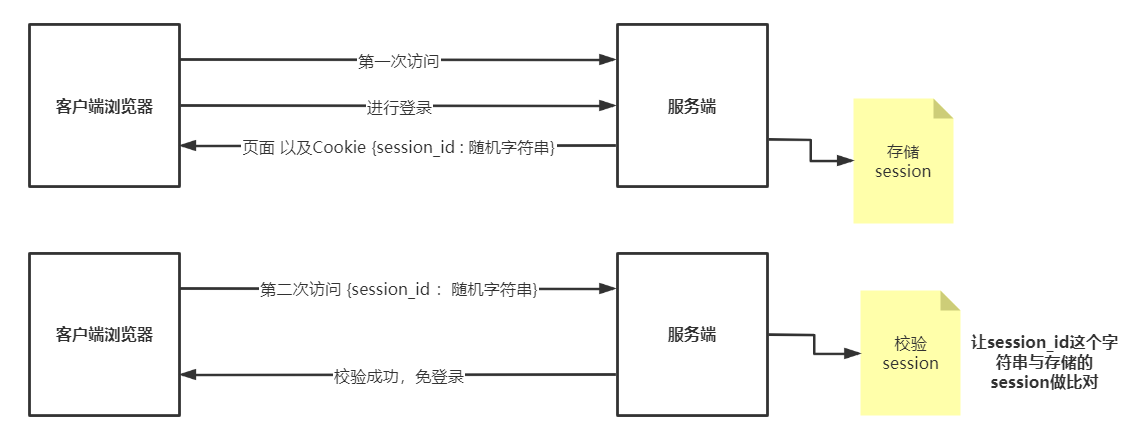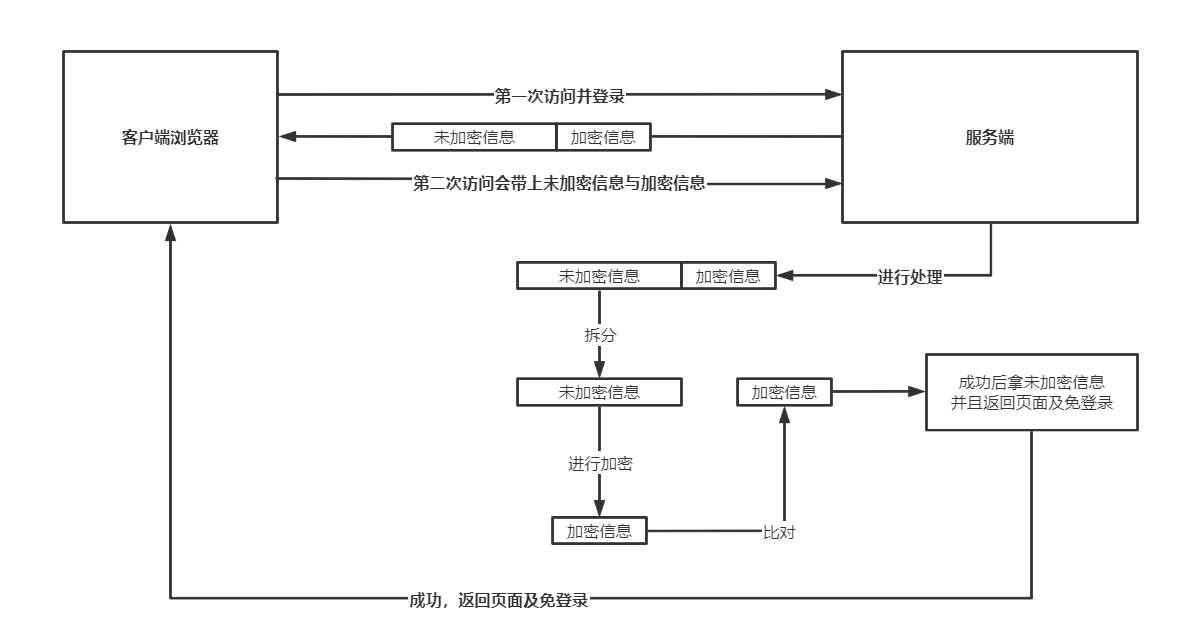HTTP无状态
HTTP具有无状态的特性,这使得每次用户的访问都需要自己输入用户名及密码进行登录,像现在诸如淘宝、京东等购物网址根本无法使用。
Cookie技术
为了解决上述问题,产生了Cookie技术。
Cookie是服务端保存至客户端浏览器上的键值对。当用户第一次登录某个网站时,该网站后端服务器会生成一组key:value的键值对(通常是账户:密码),让客户端的浏览器进行保存,下次访问的时候带上这组键值对即可。1.解决了
HTTP无状态的特性2.数据极度不安全,由于
key:value保存至本地,这使得只要窃取到该数据,就能进行伪造登录
另外,Cookie规范如下:
1.一个
Cookie所携带的内容大小上限为4KB;2.一个服务器最多在客户端浏览器上保存20个
Cookie; (20个键值对)3.一个浏览器最多保存300个
Cookie;

session技术
由于Cookie会将账户和密码的键值对全部保存至本地浏览器中,这意味着本地的Cookie一旦遭到窃取,将会面临很高的风险。
所以在数据安全等各个因素下的考虑,又出现了session技术。
session并不会将你的账户:密码键值对交给本地的浏览器进行保存,而是在服务器上进行保存(加密保存)。但是它会返回给本地浏览器一组随机的字符串,当客户端浏览器下次访问时只要带上这一组随机字符串即可。
1.
session保存的方式多种多样,可以是存放至缓存,也可以存放至硬盘2.
session无法使得同一浏览器下同一网站同时登录不同用户3.
session可能会大量占用服务端资源4.
session基于Cookie,因为本地要放上随机字符串。

其他技术
为了解决session将数据存放至服务端造成服务端资源占用过大的情况,又出现了token以及jwt。
这里简单了解一下token,关于jwt后面会单独记录。
用户第一次进行访问并登录之后,将一段用户信息进行加密处理。
把这段加密之后的结果拼接在用户信息之后,将整体的这两段信息返回给浏览器保存。
用户第二次访问时,服务端截取第一段信息进行加密,并且与第二段加密信息做比对,比对成功则代表登录成功。

Django-Cookie
以下是Django中提供的操纵Cookie的方法。
| 方法名称 | 描述 | 详细信息 |
|---|---|---|
| request.COOKIES.get("cookie") | 获取Cookie | 无 |
| set_cookie("key","value") | 设置Cookie | 参见详细信息 |
| request.delete_cookie("key") | 删除Cookie | 参见详细信息 |
我该如何获取Cookie:
# 如果当前请求的cookie中存在islogin并且有值,那么就获取,没有就用这里给的默认值None
request.COOKIES.get("islogin",None)
我该如何设置Cookie:
obj = redirect("/index/")或 HttpResponse(...) 或 render(request, ...)
# 第一种方法(推荐)
obj.set_cookie("islogin",True) # 设置cookie值,注意这里的参数,一个是键,一个是值
obj.set_cookie("lilz","344",20) # 20单位为秒,代表max_age:过期时间
obj.set_cookie("username", username)
# 第二种方法
obj.set_cookie(key,value,...)
# 第三种方法
obj.set_signed_cookie(key,value,salt='加密盐',...)
这种方法在获取时,要使用另外的获取方法
obj.get_signed_cookie(key,salt='加密盐')
# 参数注解:
max_age:过期时间
path='index'=======>表示访问index时带着cookie,其他未设置的不带cookie
domain:跨域时用
设置Cookie时的参数详解:
class HttpResponseBase:
def set_cookie(self, key, 键
value='', 值
max_age=None, 超长时间,通常设置这个即可
cookie需要延续的时间(以秒为单位)
如果参数是None ,这个cookie会延续到浏览器关闭为止。
expires=None, 超长时间,针对IE浏览器
expires默认None ,cookie失效的实际日期/时间。
path='/', Cookie生效的路径,
浏览器只会把cookie回传给带有该路径的页面,这样可以避免将
cookie传给站点中的其他的应用。
/表示根路径,特殊的:根路径的cookie可以被任何url的页面访问
domain=None, Cookie生效的域名
你可用这个参数来构造一个跨站cookie。
如, domain=".example.com"
所构造的cookie对下面这些站点都是可读的:
www.example.com 、 www2.example.com
和an.other.sub.domain.example.com 。
如果该参数设置为 None ,cookie只能由设置它的站点读取。
secure=False, 如果设置为 True ,浏览器将通过HTTPS来回传cookie。
httponly=False 只能http协议传输,无法被JavaScript获取
(不是绝对,底层抓包可以获取到也可以被覆盖)
):
'''
我该如何删除Cookie:
obj.delete_cookie("cookie_key",path="/",domain=name) # 只写key也可以进行删除
Django-session
以下是Django中设置session的一些方法。
以下是注意事项:
1.如果要设置
session,则必须先运行python manage.py migrate生成物理表,session信息会存放至物理表中。2.在
Django中,session默认的超时时间为14天。
1、设置session值
request.session["session_name"]="admin"
request.session.set_expiry(time) 设置超时时间,为秒。如果设置为0则窗口关闭失效,可以是数字,datetime,None,0
2、获取session值
session_name = request.session.get("session_name")
# 取值时:
(1) request.COOKIE.get("sessionid") 从Cookie中获取sessionid
(2) 在django-session表中根据sessionid过滤session-key
(3) 一旦对比上了,取出过滤记录的session-data反序列化数据字典 {"susername":"egon","sis_login":True},然后存入request.session,然后我们就能通过get获取字典里的值了
3、删除session值
del request.session["session_name"] # 删除一组键值对
request.session.flush() # 删除一条记录,此操作相当于下面3个步骤
(1) request.COOKIE.get("sessionid) # 取cookie中的值
(2) 在Django-session表过滤session-key的记录并删除这条记录
(3) 删除cookie,response.delete_cookie("sessionid")
# 为了减轻数据库的查询负担,过一段时间会自动把服务器的session删除(14天)
4、检测是否操作session值
if "session_name" is request.session:
FBV示例
FBV下,我们可以设置装饰器,来验证请求是否带有Cookie/session,如果没有则将先进行登录。
urls.py
urlpatterns = [
url(r'^admin/', admin.site.urls),
url(r'^index/', views.index, name="index"),
url(r'^login/', views.login, name="login"),
url(r'^logout/', views.logout, name="logout"),
url(r'^backstage/', views.backstage, name="backstage"),
url(r'^other/', views.other, name="other"),
]
app01/views.py
from django.shortcuts import render
from django.shortcuts import render
from django.shortcuts import redirect
from django.shortcuts import reverse
from django.shortcuts import HttpResponse
# Create your views here.
def wrapp(func):
def inner(request,*args,**kwargs):
if request.session.get("login"):
return func(request,*args,**kwargs)
else:
target_url = request.path_info
return redirect("/login/?next={0}".format(target_url))
return inner
def index(request):
""" 主页 """
return render(request,"index.html",locals())
def login(request):
""" 登录页面 """
target_url = request.GET.get("next",None)
if request.method == "POST":
username = request.POST.get("username")
password = request.POST.get("password")
if username == "Yunya" and password == "123456":
request.session["login"] = True
if not target_url:
return redirect("/index/") # 如果是直接点的登录页面,登陆完成后跳转到主页
else:
return redirect(target_url) # 否则跳转到从其他页面过来的
return render(request,"login.html",locals())
def logout(request):
""" 注销登录 """
del request.session["login"]
request.session.flush()
return redirect('/index/')
def backstage(request):
""" 后台页面 """
return HttpResponse("成功进入后台页面")
def other(request):
""" 其他页面 """
return HttpResponse("成功进入其他页面")
templates/index.html
<!DOCTYPE html>
<html lang="en">
<head>
<meta charset="UTF-8">
<meta name="viewport" content="width=device-width, initial-scale=1.0">
<title>Document</title>
<link href='https://cdn.bootcdn.net/ajax/libs/twitter-bootstrap/3.4.1/css/bootstrap.min.css' rel='stylesheet'>
<script src='https://cdn.bootcdn.net/ajax/libs/jquery/3.5.1/jquery.min.js'></script>
<script src='https://cdn.bootcdn.net/ajax/libs/twitter-bootstrap/3.4.1/js/bootstrap.min.js'></script>
</head>
<body>
<p><a class="btn btn-primary" href="{% url 'login' %}" role="button">登录</a></p>
<p><a class="btn btn-danger" href="{% url 'logout' %}" role="button">注销</a></p>
<h1>
主页
</h1>
</body>
</html>
templates/login.html
<!DOCTYPE html>
<html lang="en">
<head>
<meta charset="UTF-8">
<meta name="viewport" content="width=device-width, initial-scale=1.0">
<title>Document</title>
</head>
<body>
<form action="" method="POST">
<p><input type="text" placeholder="username" name="username"></p>
<p><input type="text" placeholder="password" name="password"></p>
<p><button type="submit">登录</button></p>
</form>
</body>
</html>
CBV示例
以下是使用CBV添加session认证的方式。
from django.views import View
from django.utils.decorators import method_decorator
def wrapp(func):
def inner(request, *args, **kwargs):
if request.session.get("login"):
return func(request, *args, **kwargs)
else:
target_url = request.path_info
return redirect("/login/?next={0}".format(target_url))
return inner
class Login(View):
def dispatch(self, request, *args, **kwargs):
self.target_url = request.GET.get("next", None)
return super(Login,self).dispatch(request, *args, **kwargs)
def get(self,request):
return render(request, "login.html", locals())
def post(self,request):
username = request.POST.get("username")
password = request.POST.get("password")
if username == "Yunya" and password == "123456": # 这里的验证可以新写一个方法进行
obj = redirect("/index/")
request.session["login"] = True
if not self.target_url:
return redirect("/index/")
else:
return redirect(self.target_url)
@method_decorator(wrapp,name="get")
class Logout(View):
def get(self,request):
del request.session["login"]
request.session.flush()
return redirect('/index/')